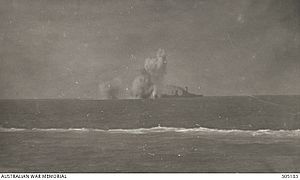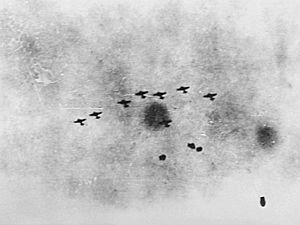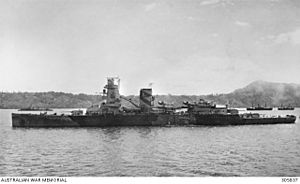Battle of the Java Sea facts for kids
Quick facts for kids Battle of the Java Sea |
|||||||
|---|---|---|---|---|---|---|---|
| Part of World War II, Pacific War | |||||||
 Bombs from a Japanese aircraft falling near the Dutch light cruiser Java in the Gaspar Strait east of Sumatra, Dutch East Indies, on 15 February 1942. |
|||||||
|
|||||||
| Belligerents | |||||||
| Allies |
|||||||
| Commanders and leaders | |||||||
| Strength | |||||||
| 2 heavy cruisers 3 light cruisers 9 destroyers |
2 heavy cruisers 2 light cruisers 14 destroyers 10 transports |
||||||
| Casualties and losses | |||||||
| 2 light cruisers sunk 3 destroyers sunk 1 heavy cruiser damaged 2,300 sailors killed |
1 destroyer damaged 1 transport damaged by air raid 36 sailors killed |
||||||
The Battle of the Java Sea was a major naval battle during World War II. It happened on February 27, 1942, in the Java Sea. This battle was a big part of the Pacific War.
In this battle, the Allied navies faced a tough defeat. They were fighting against the powerful Imperial Japanese Navy. The battle and smaller fights that followed led to Japan taking control of the Dutch East Indies. This area was important for its natural resources.
Contents
Why the Battle Happened
The Japanese wanted to expand their control in Asia. They especially wanted the rich resources of the Dutch East Indies. These resources included oil, which was vital for their war effort.
Japan started invading the Dutch East Indies very quickly. They moved from their Palau Islands colony. They captured bases in places like Sarawak and the Philippines. Japanese ships and planes moved south.
To stop them, the Allies formed a group called ABDACOM. This group included ships from the Netherlands, America, Britain, and Australia. Many of their ships were older. They tried to slow down the Japanese advance.
Before the main battle, there were smaller fights. For example, American destroyers attacked a Japanese convoy in January 1942. The Japanese also captured a big port in Sumatra. They even bombed Darwin, Australia, making it hard for the Allies to use it as a supply base.
The Main Battle
Japanese forces gathered to attack Java. On February 27, 1942, the main Allied naval force sailed out. It was led by Dutch Rear Admiral Karel Doorman. Their goal was to stop a Japanese convoy heading for Java.
Admiral Doorman's force included two heavy cruisers and three light cruisers. They also had nine destroyers. The Japanese force was led by Rear Admiral Takeo Takagi. They had two heavy cruisers, two light cruisers, and 14 destroyers. The Japanese heavy cruisers were very powerful. They had big guns and excellent torpedoes.
The battle began in the afternoon and lasted until midnight. The Allies tried to reach the Japanese troop transports. But the Japanese ships had stronger firepower. The Allies had some air support during the day. However, bad weather and Japanese radio jamming made it hard for them to work together.
The two fleets first saw each other around 4:00 PM. They started firing at 4:16 PM. Both sides had trouble hitting their targets at first. However, the British cruiser HMS Exeter was badly hit early on. It had to leave the battle.
The Japanese launched many torpedoes. One hit the Dutch destroyer HNLMS Kortenaer. It broke in half and sank quickly. Another British destroyer, HMS Electra, was also badly damaged and sank.
As night fell, the Allied fleet tried to escape. They used smoke to hide. But they were still in danger. Around 9:25 PM, the British destroyer HMS Jupiter hit a mine and sank.
Admiral Doorman's force was now much smaller. They met the Japanese ships again around 11:00 PM. In the darkness, two more Dutch cruisers, HNLMS Java and Doorman's flagship HNLMS De Ruyter, were hit by torpedoes. The Java exploded and sank fast. The De Ruyter was disabled and sank hours later. Admiral Doorman went down with his ship.
Only the Australian cruiser HMAS Perth and the American cruiser USS Houston were left. They were low on fuel and ammunition. They followed Doorman's last order to head for Batavia (now Jakarta).
Even though the Allies lost many ships, the battle did delay the Japanese invasion of Java by one day.
What Happened Next
Battle of Sunda Strait
The cruisers Perth and Houston reached Tanjung Priok. They were ordered to sail through the Sunda Strait to another port. They couldn't get more fuel or ammunition. As they left on February 28, they ran into the main Japanese invasion fleet.
In a fierce night battle, both Perth and Houston were sunk. The Japanese also lost a minesweeper and a troop transport due to friendly fire. Several other Japanese transports were damaged.
The Dutch destroyer HNLMS Evertsen (1926) was supposed to leave with the cruisers. But it was delayed. It later saw the battle happening. It tried to escape but was attacked by two Japanese destroyers. The Evertsen caught fire and had to be grounded on a reef.
Second Java Sea Battle
The damaged British cruiser Exeter left Surabaya for Sri Lanka. It was escorted by two destroyers. On March 1, these three ships were met by powerful Japanese heavy cruisers. Both Exeter and the British destroyer HMS Encounter were sunk. The American destroyer USS Pope escaped for a while but was later sunk by air attack.
Bali Strait Escape
Four American destroyers were also in Surabaya. They left for Australia on February 28. They had a brief fight with Japanese destroyers in the Bali Strait. But they managed to escape and reached Australia safely.
Results of the Battles
Other Allied ships were also lost trying to escape. The main Allied naval force was almost completely destroyed. About 10 ships and over 2,100 sailors were lost. The Battle of the Java Sea ended major Allied naval operations in Southeast Asia for 1942.
Japanese ground forces invaded Java on February 28. The Dutch navy in Asia was practically wiped out. The Netherlands never fully regained control of its colony. Japan now controlled a very important area for food and oil.
The remaining Allied forces on Java fought for about a week. Sadly, many Allied prisoners of war and local people who helped them were treated very badly by the Japanese. The Japanese won this important battle. The Allied forces surrendered on March 9.
Lost Ships
Many ships were sunk during these battles. For a long time, only the wreck of HMS Jupiter was known. It was in shallow water and had already been salvaged.
In 2002, divers found the wrecks of HNLMS Java and HNLMS De Ruyter. Later, they found HMS Electra, HNLMS Kortenaer, HMS Exeter, and HMS Encounter. When found, these wrecks were in good condition, except for battle damage.
However, by 2017, all eight of these sunken ships had been mostly or completely removed. This was due to illegal salvage operations.




